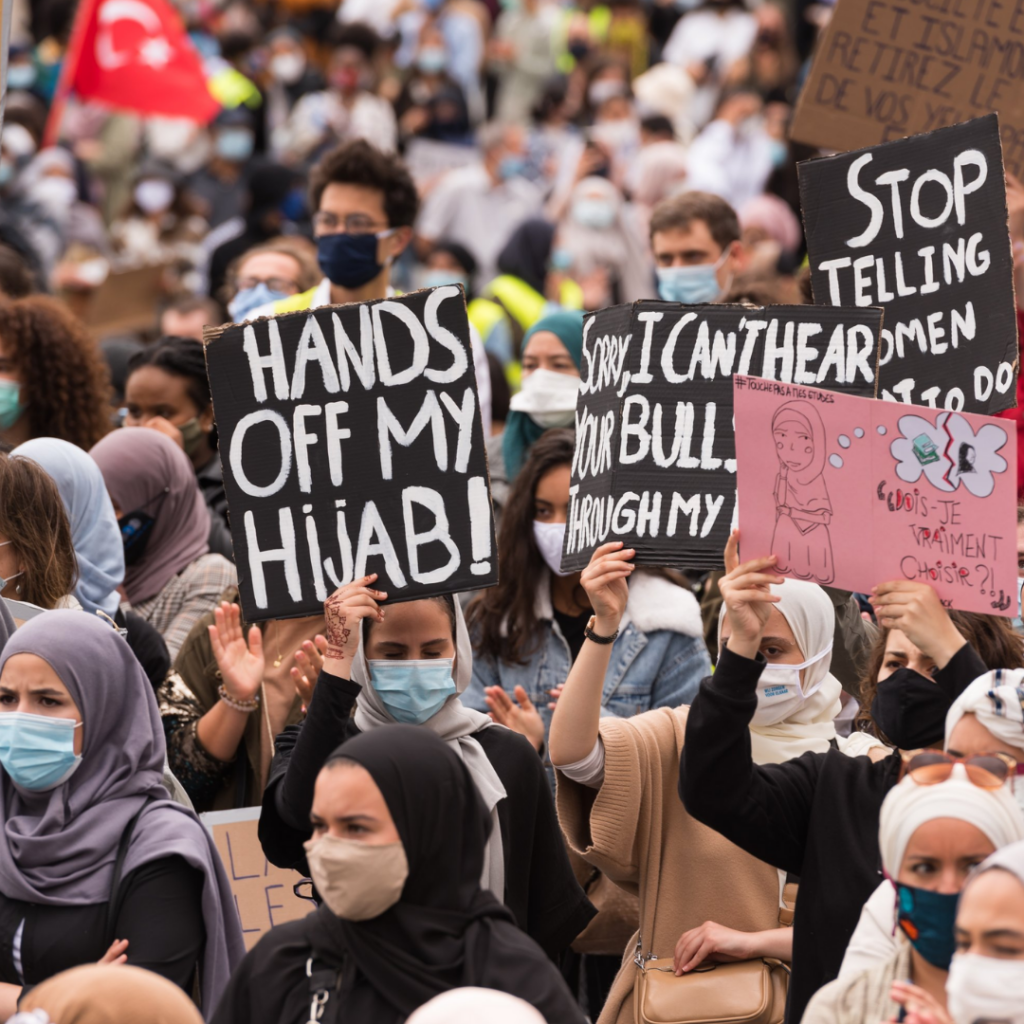As part of its controversial Separatism Bill, the French government is currently pushing forward a new ban that will not permit anyone under the age of 18 to wear a hijab. The Bill is supposedly a reaction to the increasing number of terrorist attacks in recent years. It aims to eradicate extremism and uphold the value of secularism – a key aspect of French society.
The Bill has attracted skepticism from those who claim Emmanuel Macron is succumbing to pressure from the right, particularly populists. On the international stage, the bill’s anti-Islam rhetoric has been highlighted and according to Aljazeera, Muslim women have deemed the ban a ‘law against Islam’. In response to the Bill, the hashtag #handsoffmyhijab has been trending across the world, sparking conversations about the UK’s own attitude to the hijab.
France has a history of policy that targets minority communities, particularly Muslims. In 2004 all religious symbols were banned in schools, including crosses and burqas (full-face veil), under the guise of limiting religious influences on children. Despite this law being targeted at all religions, Christians can easily divert the new rules. Those who wear a cross can simply tuck it under their shirt, but for Muslims it is practically impossible to hide a burqa or hijab.
France is not the only state to have negative perceptions of the hijab. Germany was one of the first countries to place restrictions on headscarves in education. Austria has banned burqas in most public areas and the Russian president Kadyrov has even publicly shown his support for men that attacked Muslim women with paintballs who did not follow veil restrictions. Switzerland recently voted in a national referendum to ban face coverings in public spaces in order to prevent security threats and dangerous protests, however, posters in favour of the ban showed Muslim women in burqas. These laws signal the growing presence of far-right politics within Europe.
Muslim women face serious danger when headscarves are in the political limelight as Islamophobic attacks are becoming increasingly common. According to the French Collective Against Islamophobia, attacks rose twofold in just one year between 2011 and 2012, 77% of these attacks were against Muslim women wearing a headscarf. Women have reported having their headscarf ripped off at markets as well as physical and verbal bullying.
There are several different types of headscarves worn by practising Muslim women, the most common being the hijab – a scarf that covers both the head and neck but not the face. Another popular choice among Muslim women is the Al-amira, a fitted tube-like scarf that hides the hair and head. Though the veil that has faced considerable backlash in the West are burqas, which covers the entire body, face and can be paired with a mesh eyepiece. The majority of Muslim women have the freedom to decide which veil they wear on a daily basis or even if they wear one at all.
Nabeela Jamil has explained that her personal decision to wear a hijab came as she discovered her faith as she was growing up, she was not forced by her family or community. According to Nabeela she first decided to wear a hijab as her religion suggests to cover the face and body, however, her hijab quickly became part of her self-identity. Rather than blending into society, Nabeela is proud of her headscarf, which she thinks makes her unique. As she doesn’t like to spend hours deciding on an outfit or spend her money on clothes, Nabeela finds wearing a burqa suits her lifestyle better.
In fact, a key feminist figure in the U.S is congresswoman Ilhan Omar is known for wearing her headscarf unapologetically. Particularly as she fought back against a 181-year-old headwear ban in Congress and was able to wear her hijab when taking her oath into office.
Not all Muslim women agree with this approach to headscarves. Yasmin Alibhai-Brown has criticised headscarves, deeming them to be oppressive. She is saddened that a culture that has a rich history in the advancement of arts and science continues to cling to archaic practices like the burqa. According to Yasmin, throughout the last century feminist Muslim women have fought against the veil and its misogynist rhetoric which perceives women as “sinners and temptresses”.
Prescriptive laws surrounding the hijab within Europe replicate the white-saviour complex common to colonial power structures. These laws fail to understand the cultural significance of such practices, instead viewing them through a Western framework of oppression. France’s ban on the hijab encapsulates this mentality, with politicians like Macron arguing that the law has been put in place to help Muslim women, whilst appeasing the interests of the xenophobic right-wing who perceive Islam as a threat to French society.
Caitlin Killian explains that this attitude is entrenched in the Western way of thinking. For centuries countries like Britain, France and Germany travelled the globe, extending their vision of colonial rule, exploiting any country that crossed their path. In Northern Africa and middle eastern countries in particular, veils and headscarves became a way to preserve national culture and fight back against European domination.
France is heading down a dangerous path in which minority communities are continuously targeted in an attempt to create a society where everyone looks and behaves the same. Muslim women in the West are only at the beginning of a long struggle to fight for the freedom to decide.
